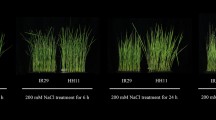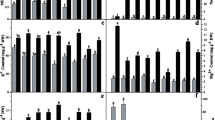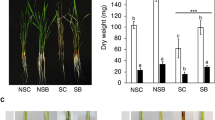Abstract
The salinity stress tolerance in plants has been studied enormously, reflecting its agronomic relevance. Despite the extensive research, limited success has been achieved in relation to the plant tolerance mechanism. The beneficial interaction between Piriformospora indica and rice could essentially improve the performance of the plant during salt stress. In this study, the transcriptomic data between P. indica treated and untreated rice roots were compared under control and salt stress conditions. Overall, 661 salt-responsive differentially expressed genes (DEGs) were detected with 161 up- and 500 down-regulated genes in all comparison groups. Gene ontology analyses indicated the DEGs were mainly enriched in “auxin-activated signaling pathway”, “water channel activity”, “integral component of plasma membrane”, “stress responses”, and “metabolic processes”. Kyoto Encyclopedia of Genes and Genomes pathway analysis revealed that the DEGs were primarily related to “Zeatin biosynthesis”, “Fatty acid elongation”, “Carotenoid biosynthesis”, and “Biosynthesis of secondary metabolites”. Particularly, genes related to cell wall modifying enzymes (e.g. invertase/pectin methylesterase inhibitor protein and arabinogalactans), phytohormones (e.g. Auxin-responsive Aux/IAA gene family, ent-kaurene synthase, and 12-oxophytodienoate reductase) and receptor-like kinases (e.g. AGC kinase and receptor protein kinase) were induced in P. indica colonized rice under salt stress condition. The differential expression of these genes implies that the coordination between hormonal crosstalk, signaling, and cell wall dynamics contributes to the higher growth and tolerance in P. indica-inoculated rice. Our results offer a valuable resource for future functional studies on salt-responsive genes that should improve the resilience and adaptation of rice against salt stress.






Similar content being viewed by others
References
Zhu JK (2001) Over expression of a delta-pyrroline-5-carboxylate synthetase gene and analysis of tolerance to water and salt stress in transgenic rice. Trends Plant Sci 6:66–72. https://doi.org/10.1104/pp.108.4.1387
Munns R, Tester M (2008) Mechanisms of salinity tolerance. Annu Rev Plant Biol 59:651–681. https://doi.org/10.1146/annurev.arplant.59.032607.092911
Jahromi F, Aroca R, Porcel R, Ruiz-Lozano JM (2008) Influence of salinity on the in vitro development of Glomus intraradices and on the in vivo physiological and molecular responses of mycorrhizal lettuce plants. Microb Ecol 55:45–53. https://doi.org/10.1007/s00248-007-9249-7
Juniper S, Abbott LK (1993) Vesicular-arbuscular mycorrhizas and soil salinity. Mycorrhiza 4:45–57. https://doi.org/10.1007/BF00204058
Hasegawa PM, Bressan RA, Zhu JK, Bohnert HJ (2000) Plant cellular and molecular responses to high salinity. Annu Rev Plant Physiol Plant Mol Biol 51:463–499. https://doi.org/10.1146/annurev.arplant.51.1.463
Roy SJ, Negrao S, Tester M (2014) Salt resistant crop plants. Curr Opin Biotechnol 26:115–124. https://doi.org/10.1016/j.copbio.2013.12.004
Apse MP, Aharon GS, Snedden WA, Blumwald E (1999) Salt tolerance conferred by overexpression of a vacuolar Na+/H+ antiport in Arabidopsis. Science 285(5431):1256–1258. https://doi.org/10.1126/science.285.5431.1256
Trivedi DK, Bhatt H, Pal RK, Tuteja R, Garg B, Johri AK, Bhavesh NS, Tuteja N (2013) Structure of RNA-interacting Cyclophilin A-like protein from Piriformospora indica that provides salinity-stress tolerance in plants. Sci Rep 3:300. https://doi.org/10.1038/srep03001
Maach M, Baghour M, Akodad M et al (2020) Overexpression of LeNHX4 improved yield, fruit quality and salt tolerance in tomato plants (Solanum lycopersicum L.). Mol Biol Rep 47(6):4145–4153. https://doi.org/10.1007/s11033-020-05499-z
Grover A, Aggarwal PK, Kapoor A, Katiyar-Agarwal S, Agarwal M, Chandramouli A (2003) Addressing abiotic stresses in agriculture through transgenic technology. Curr Sci 84:355–367
Zafar SA, Zaidi SS, Gaba Y, Singla-Pareek SL, Dhankher OP, Li X, Mansoor S, Pareek A (2020) Engineering abiotic stress tolerance via CRISPR/Cas-mediated genome editing. J Exp Bot 71(2):470–479. https://doi.org/10.1093/jxb/erz476
Sheng M, Tang M, Chen H, Yang B, Zhang F, Huang Y (2008) Influence of arbuscular mycorrhizae on photosynthesis and water status of maize plants under salt stress. Mycorrhiza 18:287–296. https://doi.org/10.1007/s00572-008-0180-7
Tisarum R, Theerawitaya C, Samphumphuang T, Polispitak K, Thongpoem P, Singh HP, Cha-um S (2020) Alleviation of salt stress in upland rice (Oryza sativa L. ssp. indica cv. Leum Pua) using arbuscular mycorrhizal fungi inoculation. Front Plant Sci 11:348. https://doi.org/10.3389/fpls.2020.00348
Augé RM, Toler HD, Sams CE, Nasim G (2008) Hydraulic conductance and water potential gradients in squash leaves showing mycorrhiza-induced increases in stomatal conductance. Mycorrhiza 18(3):115–121. https://doi.org/10.1007/s00572-008-0162-9
Kumar A, Sharma S, Mishra S (2010) Influence of arbuscular mycorrhizal (AM) fungi and salinity on seedlings growth, solute accumulation, and mycorrhizal dependency of Jatropha curcas L. J Plant Growth Regul 29:297–306. https://doi.org/10.1007/s00344-009-9136-1
Ruiz-Lozano JM (2003) Arbuscular mycorrhizal symbiosis and alleviation of osmotic stress: new perspectives for molecular studies. Mycorrhiza 13:309–317. https://doi.org/10.1007/s00572-003-0237-6
Verma S, Varma A, Rexer K, Hassel A, Kost G, Sarbhoy A, Bisen P, Bütehorn B, Franken P (1998) Piriformospora indica, gen. et sp. nov, a new root-colonizing fungus. Mycologia 90:896–903. https://doi.org/10.1080/00275514.1998.12026983
Schäfer P, Pfiffi S, Voll LM, Zajic D, Chandler PM, Waller F et al (2009) Manipulation of plant innate immunity and gibberellin as factor of compatibility in the mutualistic association of barley roots with Piriformospora indica. Plant J 59(3):461–474. https://doi.org/10.1111/j.1365-313X.2009.03887.x
Waller F, Achatz B, Baltruschat H (2005) The endophytic fungus Piriformospora indica reprograms barley to salt-stress tolerance, disease resistance, and higher yield. Proc Natl Acad Sci USA 102:13386–13391. https://doi.org/10.1073/pnas.0504423102
Gazara RK, de Oliveira EAG, Rodrigues BC et al (2019) Transcriptional landscape of soybean (Glycine max) embryonic axes during germination in the presence of paclobutrazol, a gibberellin biosynthesis inhibitor. Sci Rep 9:9601. https://doi.org/10.1038/s41598-019-45898-2
Cadavid IC, Guzman F, de Oliveira-Busatto L, de Almeida RMC, Margis R (2020) Transcriptional analyses of two soybean cultivars under salt stress. Mol Biol Rep 47:2871–2888. https://doi.org/10.1007/s11033-020-05398-3
Murashige T, Skoog F (1962) A revised medium for rapid growth and bio assays with tobacco tissue cultures. Physiol Plant 15:473–497. https://doi.org/10.1111/j.1399-3054.1962.tb08052.x
Johnson JM, Sherameti I, Ludwig A, Nongbri PL, Sun C, Lou B, Varma A, Oelmüller R (2011) Protocols for Arabidopsis thaliana and Piriformospora indicacocultivation: a model system to study plant beneficial traits. Endocyt Cell Res 21:101–113
Heath RL, Packer L (1968) Photoperoxidation in isolated chloroplasts. I. Kinetics and stoichiometry of fatty acid peroxidation. Arch Biochem Biophys 125:189–198. https://doi.org/10.1016/0003-9861(68)90654-1
Livak KJ, Schmittgen TD (2001) Analysis of relative gene expression data using real-time quantitative PCR and the 2-ΔΔCT method. Methods 25:402–408. https://doi.org/10.1006/meth.2001.1262
Zafar SA, Hameed A, Ashraf M et al (2020) Agronomic, physiological and molecular characterisation of rice mutants revealed the key role of reactive oxygen species and catalase in high-temperature stress tolerance. Funct Plant Biol 47(5):440–453. https://doi.org/10.1071/fp19246
Bielach A, Hrtyan M, Tognetti V (2017) Plants under stress: involvement of auxin and cytokinin. Int J Mol Sci 18:1427
An P, Li X, Zheng Y, Matsuura A, Abe J, Eneji AE, Tanimoto E, Inanaga S (2014) Effects of NaCl on root growth and cell wall composition of two soya bean cultivars with contrasting salt tolerance. J Agro Crop Sci 200:212–218. https://doi.org/10.1111/jac.12060
Fan P, Nie L, Jiang P, Feng J, Lv S, Chen X, Bao H, Guo J, Tai F, Wang J et al (2013) Transcriptome analysis of Salicornia europaea under saline conditions revealed the adaptive primary metabolic pathways as early events to facilitate salt adaptation. PLoS ONE 8:e80595. https://doi.org/10.1371/journal.pone.0080595
Formentin E, Sudiro C, Perin G, Riccadonna S, Barizza E, Baldoni E, Lavezzo E, Stevanato P, Sacchi GA, Fontana P, Toppo S, Morosinotto T, Zottini M, Lo Schiavo F (2018) Transcriptome and cell physiological analyses in different rice cultivars provide new insights into adaptive and salinity stress responses. Front Plant Sci 9:204. https://doi.org/10.3389/Ffpls.2018.00204
Hanin M, Ebel C, Ngom M, Laplaze L, Masmoudi K (2016) New insights on plant salt tolerance mechanisms and their potential use for breeding. Front Plant Sci 7:1787. https://doi.org/10.3389/Ffpls.2016.01787
Li N, Liu H, Sun J et al (2018) Transcriptome analysis of two contrasting rice cultivars during alkaline stress. Sci Rep 8(1):9586. https://doi.org/10.1038/s41598-018-27940-x
Rahman H, Jagadeeshselvam N, Valarmathi R et al (2014) Transcriptome analysis of salinity responsiveness in contrasting genotypes of finger millet (Eleusine coracana L.) through RNA sequencing. Plant Mol Biol 85:485. https://doi.org/10.1007/s11103-014-0199-4
Denancé N, Szurek B, Noël LD (2014) Emerging functions of nodulin-like proteins in nonnodulating plant species. Plant Cell Physiol 55(3):469–474. https://doi.org/10.1093/pcp/pct198
Kapilan R, Vaziri M, Zwiazek JJ (2018) Regulation of aquaporins in plants under stress. Biol Res 51:4. https://doi.org/10.1186/s40659-018-0152-0
Palmer AJ, Baker A, Muench SP (2016) The varied functions of aluminium-activated malate transporters–much more than aluminium resistance. Biochem Soc Trans 44(3):856–862. https://doi.org/10.1042/BST20160027
Golldack D, Quigley F, Michalowski CB et al (2003) Salinity stress tolerant and sensitive rice (Oryza sativa L.) regulate AKT1-type potassium channel transcripts differently. Plant Mol Biol 51:71–81. https://doi.org/10.1023/A:1020763218045
Wang R, Jing W, Xiao L, Jin Y, Shen L, Zhang W (2015) The rice high-affinity potassium transporter1;1 is involved in salt tolerance and regulated by an MYB-type transcription factor. Plant Physiol 168(3):1076–1090. https://doi.org/10.1104/pp.15.00298
Fuchs I, Stölzle S, Ivashikina N et al (2005) Rice K+ uptake channel OsAKT1 is sensitive to salt stress. Planta 221:212–221. https://doi.org/10.1007/s00425-004-1437-9
Laurie S, Feeney KA, Maathuis FJM, Heard PJ, Brown SJ, Leigh RA (2002) A role for HKT1 in sodium uptake by wheat roots. Plant J 32:139–149. https://doi.org/10.1046/j.1365-313X.2002.01410.x
Stone JM, Walker JC (1995) Plant protein kinase families and signal transduction. Plant Physiol 108(2):451–457. https://doi.org/10.1104/pp.108.2.451
Wagner A, Kohorn BD (2001) Wall-associated kinases are expressed throughout plant development and are required for cell expansion. Plant Cell 13(303):318. https://doi.org/10.1105/tpc.13.2.303
Yu J, Zao W, He Q, Kim TS, Park YJ (2017) Genome-wide association study and gene set analysis for understanding candidate genes involved in salt tolerance at the rice seedling stage. Mol Genet Genomics 292:1391–1403. https://doi.org/10.1007/s00438-017-1354-9
Michal-Johnson J, Lee YC, Camehl I, Sun C, Yeh KW, Oelmuller R (2013) Piriformospora indica promotes growth of chinese cabbage by manipulating auxin homeostasis-role of auxin in symbiosis. In: Varma A, Kost G, Oelmüller R (eds) Piriformospora indica: sebacinales and their biotechnological applications. Springer, Berlin
Vadassery J, Ritter C, Venus Y, Camehl I, Varma A, Shahollari B, Novák O, Strnad M, LudwigMüller J, Oelmüller R (2008) The role of auxins and cytokinins in the mutualistic interaction between Arabidopsis and Piriformospora indica. Molecular Plant 21:1371–1383. https://doi.org/10.1094/MPMI-21-10-1371
Gardner H (1995) Biological roles and biochemistry of the lipoxygenase pathway. HortScience 30:197. https://doi.org/10.21273/HORTSCI.30.2.197
Kang D, Seo Y, Lee J, Ishii R, Kim K, Shin D, Park S, Jang S, Lee I (2005) Jasmonic acid differentially affects growth, ion uptake and abscisic acid concentration in salt-tolerant and salt sensitive rice cultivars. J Agron Crop Sci 191:273–282. https://doi.org/10.1111/j.1439-037X.2005.00153.x
Keskin BC, Sarikaya AT, Yüksel B, Memon AR (2010) Abscisic acid regulated gene expression in bread wheat (Triticum aestivum L.). Aust J Crop Sci 4:617–625
Jung H, Lee DK, Choi YD, Kim JK (2015) OsIAA6, a member of the rice Aux/IAA gene family, is involved in drought tolerance and tiller outgrowth. Plant Sci 236:304–312. https://doi.org/10.1016/j.plantsci.2015.04.018
Qiu T, Qi M, Ding X et al (2020) The SAUR41 subfamily of SMALL AUXIN UP RNA genes is abscisic acid inducible to modulate cell expansion and salt tolerance in Arabidopsis thaliana seedlings. Ann Bot 125(5):805–819. https://doi.org/10.1093/aob/mcz160
Carvalho AO, Gomes VM (2011) Plant defensins and defensin-like peptides- biological activities and biotechnological applications. Curr Pharm Design 17(38):4270–4293. https://doi.org/10.2174/138161211798999447
Figueiredo A, Monteiro F, Sebastiana M (2014) Subtilisin-like proteases in plant-pathogen recognition and immune priming: a perspective. Front Plant Sci 5:739. https://doi.org/10.3389/fpls.2014.00739
Sharma A, Hussain A, Mun BG, Imran QM, Falak N, Lee SU, Yun BW (2016) Comprehensive analysis of plant rapid alkalization factor (RALF) genes. Plant Physiol Biochem 106:82–90. https://doi.org/10.1016/j.plaphy.2016.03.037
Cosgrove D (2005) Growth of the plant cell wall. Nat Rev Mol Cell Biol 6:850–861. https://doi.org/10.1038/nrm1746
Eklöf JM, Brumer H (2010) The XTH gene family: an update on enzyme structure, function, and phylogeny in xyloglucan remodeling. Plant Physiol 153:456–466. https://doi.org/10.1104/pp.110.156844
Sénéchal F, Wattier C, Rustérucci C, Pelloux J (2014) Homogalacturonan-modifying enzymes: structure, expression, and roles in plants. J Exp Bot 65:5125–5160. https://doi.org/10.1093/jxb/eru272
Kalunke RM, Tundo S, Benedetti M, Cervone F, De Lorenzo G, D'Ovidio R (2015) An update on polygalacturonase-inhibiting protein (PGIP), a leucine-rich repeat protein that protects crop plants against pathogens. Front Plant Sci 6:146. https://doi.org/10.3389/fpls.2015.00146
Lamport DTA, Kieliszewski MJ, Showalter AM (2006) Salt stress upregulates periplasmic arabinogalactan proteins: using salt stress to analyse AGP function. New Phytol 169:479–492. https://doi.org/10.1111/j.1469-8137.2005.01591.x
Zhao C, Zayed O, Zeng F et al (2019) Arabinose biosynthesis is critical for salt stress tolerance in Arabidopsis. New Phytol 224(1):274–290. https://doi.org/10.1111/nph.15867
Liang J, Guo S, Sun B, Liu Q, Chen X, Peng H, Zhang Z, Xie Q (2018) Constitutive expression of REL1 confers the rice response to drought stress and abscisic acid. Rice (New York, NY) 11(1):59. https://doi.org/10.1186/s12284-018-0251-0
Madson M, Dunand C, Li X, Verma R, Vanzin GF, Caplan J, Shoue DA, Carpita NC, Reiter WD (2003) The MUR3 gene of arabidopsis encodes a xyloglucan galactosyltransferase that is evolutionarily related to animal exostosins. Plant Cell 15(7):1662–1670. https://doi.org/10.1105/tpc.009837
Zhu J, Lee BH, Dellinger M, Cui X, Zhang C, Wu S, Nothnagel EA, Zhu JK (2010) A cellulose synthase-like protein is required for osmotic stress tolerance in Arabidopsis. Plant J 63(1):128–140. https://doi.org/10.1111/j.1365-313X.2010.04227.x
Li W, Shao M, Yang J, Zhong W, Okada K, Yamane H, Qian G, Liu F (2013) Oscyp71Z2 involves diterpenoid phytoalexin biosynthesis that contributes to bacterial blight resistance in rice. Plant Sci 207:98–107. https://doi.org/10.1016/j.plantsci.2013.02.005
Chen M, Xu J, Devis D, Shi J, Ren K, Searle I, Zhang D (2016) Origin and functional prediction of pollen allergens in plants. Plant physiol 172(1):341–357. https://doi.org/10.1104/pp.16.00625
Pii Y, Astegno A, Peroni E, Zaccardelli M, Pandolfini T, Crimi M (2009) The Medicago truncatula N5 gene encoding a root-specific lipid transfer protein is required for the symbiotic interaction with Sinorhizobium meliloti. Mol Plant Microbe Interact 22(12):1577–1587. https://doi.org/10.1094/MPMI-22-12-1577
Acknowledgements
The financial support of Science and Engineering Research Board (SERB), Department of Science and Technology, Government of India, New Delhi (Grant Sanction Number SB/YS/LS-111/2014 2014) is greatly acknowledged. The authors are also grateful to AgriGenome Labs Pvt Ltd team for transcriptome sequencing and data analysis.
Author information
Authors and Affiliations
Contributions
N conducted the experiments and wrote the initial drafts of manuscript. RKG performed the data analysis, and helped in the manuscript editing. SK contributed in performing quantitative RT-PCR for data validation. SI and KA contributed in sample collection and RNA extraction. N and MZA planned and designed the research, evaluated the scientific implications of the transcriptome data, and prepared the final maunscript. All author approved the final manuscript.
Corresponding author
Ethics declarations
Conflict of interest
The authors declare that they have no conflict of interest.
Human and animal rights
The present study did not involve any Human participants and/or Animals.
Additional information
Publisher's Note
Springer Nature remains neutral with regard to jurisdictional claims in published maps and institutional affiliations.
Electronic supplementary material
Below is the link to the electronic supplementary material.
Rights and permissions
About this article
Cite this article
Nivedita, Gazara, R.K., Khan, S. et al. Comparative transcriptome profiling of rice colonized with beneficial endophyte, Piriformospora indica, under high salinity environment. Mol Biol Rep 47, 7655–7673 (2020). https://doi.org/10.1007/s11033-020-05839-z
Received:
Accepted:
Published:
Issue Date:
DOI: https://doi.org/10.1007/s11033-020-05839-z




